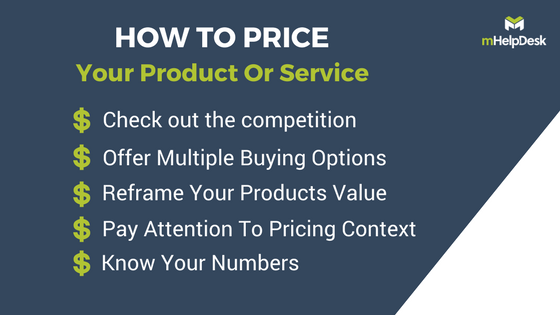This post was written by Eric Asker, Webinar Manager at mHelpDesk.
“Most customers are more likely to buy a service at $99/month than at $1,150/year, even though the second price is actually slightly cheaper.”
Pricing is critical to success. It can drive sales and growth for your business, or it can do the opposite, stifling your business’s potential to earn and expand. Considering the implications pricing has for your profits and growth, it’s no wonder business owners everywhere put so much thought into determining where to set their prices. This article contains 5 helpful tips that you can use to determine the best pricing structure for your business. Before you start setting prices though, it’s vitally important to first decide what the goal of your pricing is.
What exactly is it that you want your pricing to be doing for your business? For the majority of businesses, the goal of pricing is to generate maximum revenue, but this isn’t always the case. For example, if your business needs to attract customers, then perhaps you are willing to make lower profits temporarily in order to attract a larger customer base. As another example, perhaps your business already has a healthy customer base/cash reserves, and your goal is to sink your competition. In such a case, you may go so far as to momentarily operate at a loss to offer exceedingly competitive prices and take customers from your competitors. Regardless of where you land, once you determine what you want your pricing to do for you, you can move on to actually determining your price.
Here are 5 great tips to help you set your pricing, and make sure your pricing is helping and not hindering your business.

1. Check the Competition
When it comes to pricing, never skip this step. Customers in different places are are used to paying different amounts for different services. Pick out several competitors who you consider to be successful, and compare their pricing models to get a feel for what works in your industry in your area. Depending on the goal of your pricing, you will probably want to beat or match your competitors’ prices, but then again, if your business strategy is to provide premium service for high-end clients, you will want to charge more than your competition since many customers associate price with quality. However as you will see in the next tip, it is possible to attack multiple angles simultaneously.
2. Offer Multiple Buying Options
As you would expect, even within the same area and industry, different customers are willing to pay different amounts for your services. Offering different buying options is a great way to make sure you have every type of customer covered and that you don’t leave any money or potential clients on the table. In other words, why only aim at middle-of-the-pack or high-end customers when you can offer multiple buying options and cover everyone?
Think about it, if you only have one price point, then by definition you are missing out on revenue from any customer who would have been willing to pay you more for your services. You are also missing out on any customers who would have bought if you’d pitched them at a lower price. By increasing the amount of price points you have, you will in turn increase the amount of potential customers who will buy from you. This strategy is so effective that you see it used by companies in nearly every industry, whether you’re looking at different phone plans, health insurance options — you name it.
If you like the idea of multiple buying options but don’t know what those options should be, some common examples are added warranties, included maintenance visits, or free appointments if the customer buys a certain amount in advance. There are endless variations though, so take the time to investigate your competition and emulate any creative buying options or packages they are offering.
3. Reframe Your Product’s Value
Is it possible to change your services perceived value without changing your profit margins? Absolutely! Consider altering the way you are communicating pricing to the customer. For example, most customers are more likely to buy a service at $99/month than at $1,150/year, even though the second price is actually slightly cheaper. This is in part because it’s easier for customers to assess the value of a month of service compared to a year, but it’s also simply because 99 is a lower number than 1,150.
Another easy way to reframe your product/services’s value is to put a different, contrasting price next to it. This can be your competitors price, or, if you liked the idea of number 2 on this list, a different buying option. It can even pay to use an inflated “decoy” price (you can call it your “enterprise”, or “premium” package) that makes your mid-level bundle seem like a huge savings.
Alternatively, you could use a decoy mid-level option that’s close in price to your “premium” package, but missing many of your “premium” options benefits. This makes your most expensive price seem like a better value. An everyday example of this strategy can be seen when buying concessions at the movie theater. You just wanted a $6.50 soft drink, but then you see a drink and popcorn is $7. You didn’t really care about popcorn, but if it’s only $0.50 more, then hey why not. And boom, just like that you’ve been upsold!
4. Pay Attention to Pricing Context
Imagine two bottles of beer, identical in every way except for the location at which they were purchased. Which one is worth more? Most logical people would say they are worth the same amount, but in reality the value of even identical products is determined by the context in which it’s presented. In an experiment, economist Richard Thaler was able to determine that people are willing to pay more for a beer if they believe it was bought at an upscale hotel as opposed to a grocery store, even if they are not in the establishment when they order and consume it.
This strange quirk of human psychology just goes to show how important it is make your business stand out as a professional organization that can guarantee results. If every other company in your area is showing up to job sites with a beat up car, an old t-shirt, and carbon paper, and you show up in a branded vehicle, have employees dressed in matching shirts and are armed with a tablet and state-of-the art software, you will literally be able to charge more for your services because you are promoting yourself as a professional, trustworthy company.
Another great way to change the context of your prices are to leverage reviews and testimonials. If you have a 5 star rating online, make sure you are advertising that fact. If you have an amazing customer testimonial, use it on your website or in your advertising. The average customer will gladly pay a little more for your services if they feel like you will get them the best results.
5. Know Your Numbers
Do you have an easy way to track and measure the difference pricing makes to your business? If not, nothing else on this list will matter. You can’t guess your way to a perfect business. You need a way to actively track the money your business is generating and whether or not changes you make to your pricing model (or anything else!) are affecting your profits positively or negatively.
If you don’t have this covered already, consider a business software solution, like mHelpDesk. The new breed of affordable software tools available to small businesses today will do wonders for any business owner. If you are operating out of mHelpdesk, you will quite literally have access to your profit margins, revenue generated by lead source, revenue generated by ad campaign, and dozens of other incredibly useful reports. I can’t stress enough how important it is to have quick, easy access to your numbers. Don’t just think that your business is operating at maximum profitability, know that you are.
Wrap Up
The final thing to remember when setting your price is that pricing and sales will always be intertwined. A well-set price will never replace a skilled salesman, and a skilled salesman will never replace a well-set price. To be successful, make sure you have visibility over the performance of your sales team and it’s relation to your business’s bottom line.
Found these tips to be helpful? We invite you to share this on social media or leave us your thoughts in the comments section below.
Last Updated By: Rochelle Sanchirico
Field Service Automation
Service Solutions
Last modified: January 15, 2018









